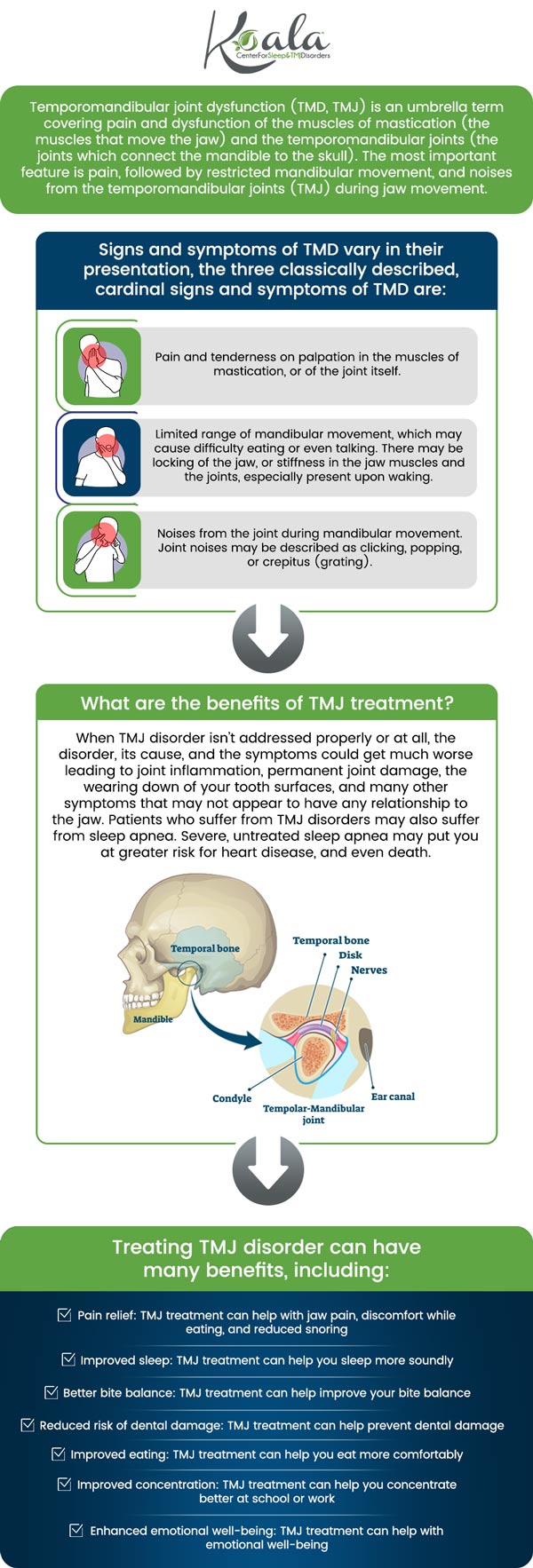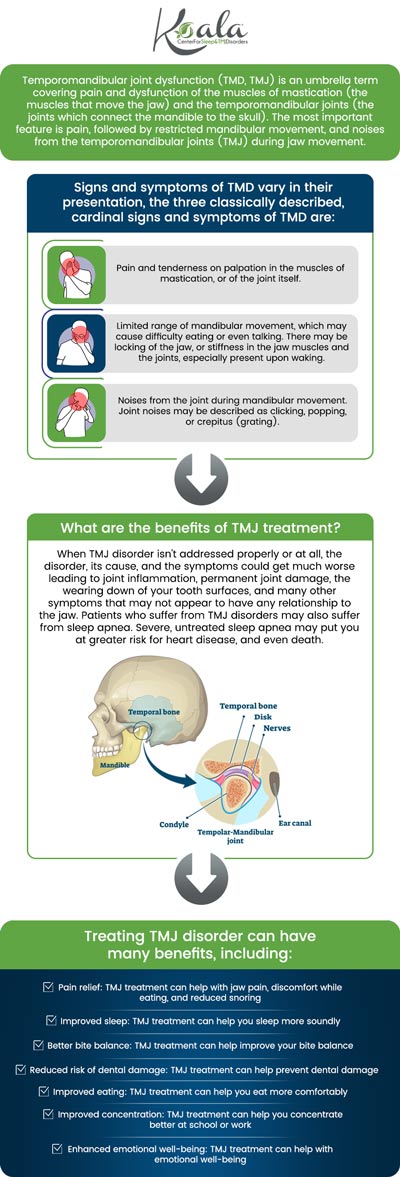How Do You Permanently Cure TMJ?
Learn how to combat TMJ with the right healthcare team today. Call our team dedicated Dentists today at Koala® Center For Sleep & TMJ Disorders or visit us online to book an appointment. We have convenient locations across the U.S. in Bloomington IL, Peoria/Dunlap IL, El Paso TX and Wausau WI.




Table of Content:
How do you permanently cure TMJ?
How long does it take to get rid of TMJ?
Can TMJ go away and come back?
Though health care professionals cannot guarantee a patient’s TMJ to be curable, it is possible as there are numerous treatment options for those experiencing the joint condition. If your TMJ is minor, you may be able to relinquish your symptoms after using consistent treatment methods.
These include oral appliances such as splints and mouthguards, therapies, medications, and general lifestyle changes. Many patients find using splints and mouthguards to help stabilize their jaw and prevent teeth grinding and clenching in the night, will ultimately alleviate some of their pain. Though you may not believe a physical therapist to be helpful to TMJ patients, they can provide highly personalized exercise and stretch regimens that work to strengthen the jaw and joint. Further, they can suggest and help you regulate other treatments you use and provide patient education.
Self-management is key to the recovery of many conditions; the more educated a patient is on their health, the more they can participate in the knowledge-based recovery. TENS therapy, transcutaneous electrical nerve stimulation, has proven to be a highly effective and non-invasive treatment for pain. Also, hot and cold treatment by the use of compresses can help to reduce inflammation and pain. Various pain-relieving and anti-inflammatory medications such as ibuprofen (Advil, Motrin) or acetaminophen (Tylenol) can be used to lessen symptoms of TMJ. Tricyclic antidepressants, such as amitriptyline (Elavil, etc.), may also be prescribed in low doses for pain relief. Diazepam (Valium) can address clenching and grinding of the teeth commonly associated with TMJ pain, as it has antispasmodic effects. Surgical options may be considered should your TMJ progressively worsen and is not aided by the above treatments.
Arthrocentesis is a standard minimally invasive procedure that is often the first surgical option for patients. In the temporomandibular joint (TMJ), the skull’s mandible (jaw bone) and temporal bone meet like a modified hinge, with a small disc between the two ends. In the joint, synovial fluid fills a sac that allows for more effortless gliding and prevents bone and cartilage wear. This articular disc can dislocate the same way a knee can, resulting in fluid build-up in the joint. An arthrocentesis addresses this issue and removes excess fluid using a small needle.
Suppose your TMJ does not seem to be getting better with treatment or has an unknown cause. In that case, a surgeon may perform arthroscopy, a minimally invasive procedure in which a small tube and camera can be inserted into the joint to determine the root of your symptoms. Some repairs may be made through this procedure simultaneously.
A more invasive procedure, a modified condylotomy, may be done to relieve pain and is performed by disconnecting and lowering the posterior mandible (back of the jawbone). In the most extreme case, an arthrotomy is an open procedure that allows a surgeon to repair and reshape the joint or remove and replace parts of the joint with artificial implants.
The amount of time it will take to get rid of TMJ symptoms will depend on the severity and reason of the condition, as well as treatment. With various therapies, minor TMJ will likely improve in weeks or months. Patients primarily using oral appliances, like mouthguards and splints, may feel their symptoms be eased, though others may use this option for years without improvement.
Should you need a minimally invasive procedure like arthrocentesis, you can expect long-term relief and a recovery period of less than a week. A modified condyloma may provide permanent relief from TMJ, in which a full recovery would last two to six weeks. An arthrotomy of the TMJ could also offer permanent relief, though the healing can take three to six weeks.
Yes, TMJ can go away with proper treatment, and it can come back. If your TMJ was mild and you could dissipate symptoms with lifestyle changes and non-surgical treatments, you will likely need to continue these actions to prevent TMJ from returning.
Minimally invasive surgical treatments can provide long-term relief but not prevent TMJ from returning. More invasive procedures are likely to “cure” TMJ permanently, though their success will never be 100%.
Here at Koala® Center For Sleep & TMJ Disorders, we have a highly educated team specializing in various fields, including TMJ treatment. We are fully prepared to aid you in your recovery from TMJ disorder and strive to optimize your health outcomes. Please, do not hesitate to book an appointment online or by phone to meet with one of our exceptional staff.

Additional Services You May Need
▸ KoalaKIDZzz®
▸ Sleep Apnea
▸ Snoring
▸ TMJ Disorder
▸ Fatigue
▸ Sleep Disorders
▸ Weight Loss
▸ CPAP Alternative
▸ Oral Appliances




